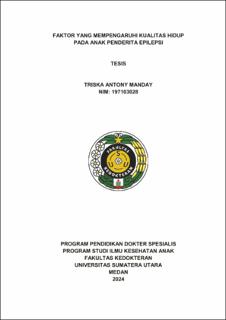Faktor yang Mempengaruhi Kualitas Hidup pada Anak Penderita Epilepsi
The Relationship of Migraine with Quality of Life in Children with Epilepsy

Date
2024Author
Manday, Triska Antony
Advisor(s)
Dimyati, Yazid
Lubis, Bugis Mardina
Metadata
Show full item recordAbstract
BACKGROUND: Epilepsy is a brief seizure caused by unsynchronized neuronal activity, recognized by a tendency to recurrent seizures without cause. Childhood epilepsy and migraine are two of the most common conditions in pediatric neurology. Children with epilepsy are at risk of experiencing a decrease in overall quality of life and reduced family activities or an impact on mental health. There is some evidence that children with migraine experience a lower quality of life than children without epilepsy. The aim of this study was to analyze the relationship between migraine and the quality of life of children with epilepsy.
METHOD: This is an analytic reserch with a cross sectional design conducted in Adam Malik Hospital from May to June 2024. Migraine assessment and quality of life were assessed using a questionnaire. Statistical analysis was carried out using the Chi square test to determine the relationship between migraine and the quality of life of children with epilepsy.
RESULT: A total of 89 epileptic children met the criteria in this study. There were 11 (37.9%) migraineurs with good quality of life, and 118 (62.1%) with poor quality of life. Meanwhile, 43 (71.7%) had no migraine with good quality of life, and 17 (28.3%) had no migraine with poor quality of life. Using the Chi Square test, the p value = 0.02. The results of the analysis show that there is a relationship between migraines and quality of life in children with epilepsy.
CONCLUSION: There is a relationship between migraines and the quality of life of children with epilepsy.
Collections
- Master Theses [362]
